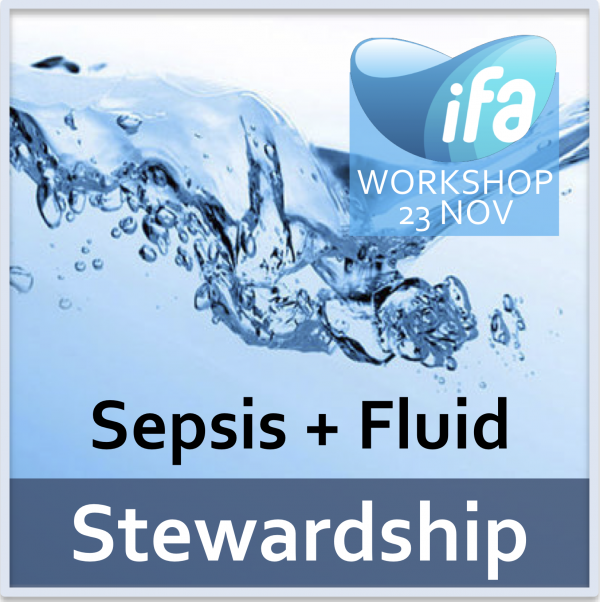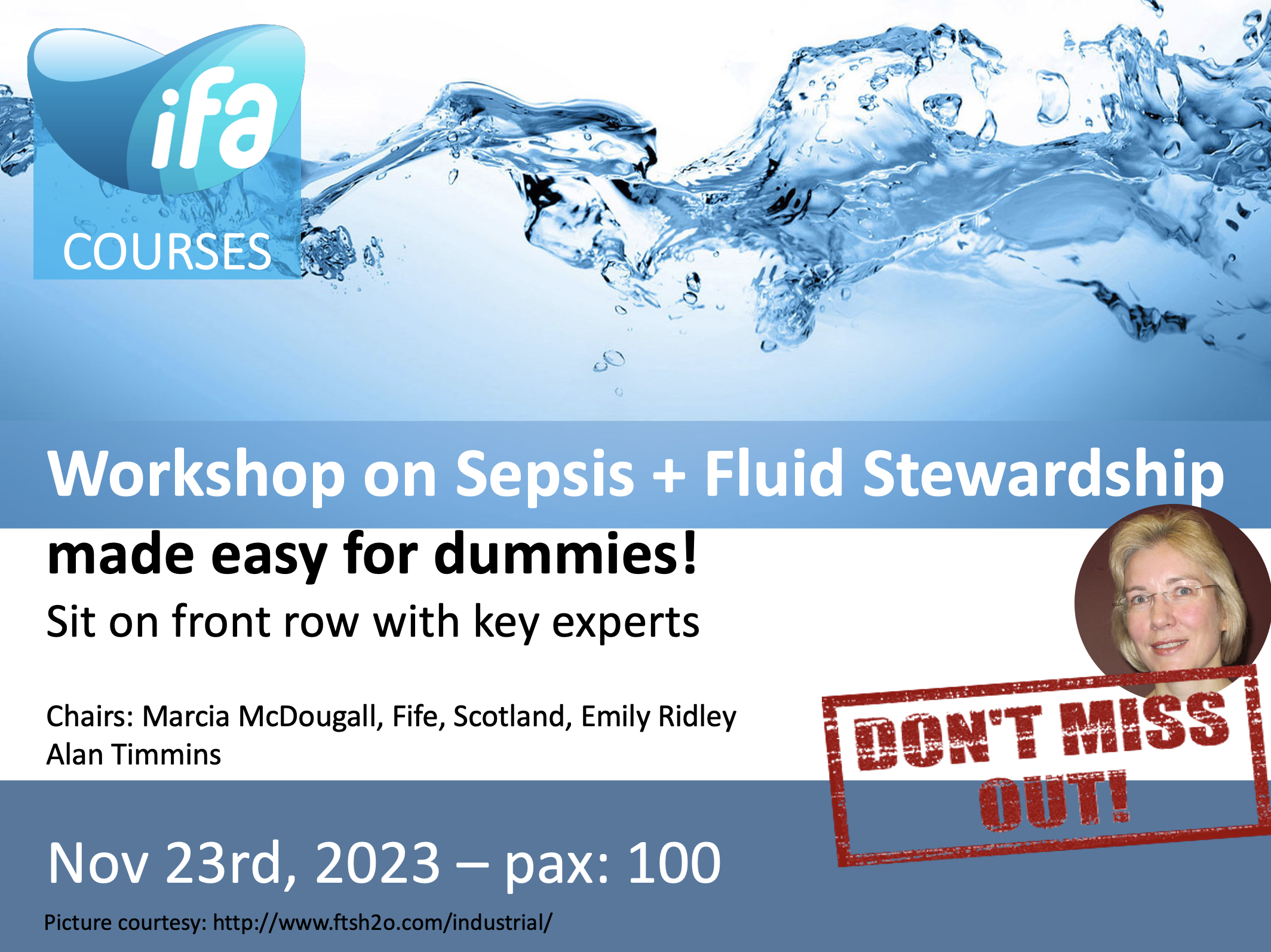
2nd Workshop on sepsis and fluid stewardship
How to set up a sepsis and fluid guideline in your unit (Limited places during IFAD2023)
Date: November 23rd, 2023
Location: Hilton Congress Centre, Groenplaats, Antwerp, Belgium
Room: Belle Epoque
Scientific Program Chairs: Prof Dr Manu Malbrain, Professor Critical care Research, Medical University Lublin, Poland, Dr Niels Van Regenmortel, ICU Director, ZNA Stuivenberg, Antwerp, Belgium
Program Chairs: Dr Marcia McDougall
Speakers:
Marcia McDougall
Alan Timmins
Manu Malbrain
Emily Ridley
Duration: full day
Pax: 100
Price: 150 EUR
Background:
Sepsis Care Bundles and national sepsis plan: Definitions of sepsis and septic shock were revised in 2001. Considerable advances have since been made into the pathobiology (changes in organ function, morphology, cell biology, biochemistry, immunology, and circulation), management, and epidemiology of sepsis, suggesting the need for reexamination. This formed the basis for the new Sepsis 3.0 definitions. Also recently the updates of the surviving sepsis campaign guidelines was published. For the first time parameters assessing fluid responsiveness were included and the CVP criterion was abandoned. However when adhering to the SSCG, every patient with sepsis regardless of his/her comorbidities should receive 30 ml/kg in the first 3 hours according to the SEP-1 mandate.
Fluid Guidelines: Where do we start?
Fluid prescribing has been shown in the UK to be associated with significant morbidity and mortality: it has been estimated that up to 20% of patients who receive intravenous fluids suffer iatrogenic harm as a result. It is therefore an area in which investing some effort in improvement is likely to prevent a great deal of patient harm. There are now national guidelines in the UK for intravenous fluid therapy in Adults, the NICE Guidelines. In our large district general hospital in Fife, Scotland, we developed a local version of these guidelines and have implemented them over a number of years through several steps. In this workshop the pitfalls and challenges of introducing large-scale change such as this will be examined and suggestions made as to how you may be able to effect change in this rewarding and immensely important area of healthcare.
Learning objectives
This workshop will outline the basic principles in the treatment of sepsis and septic shock that underlie the need for individualized and personalized care. This workshop will help to understand the mechanisms of sepsis and how to implement the guidelines at the bedside. In analogy to antibiotic stewardship, you will learn about sepsis stewardship. In this workshop, different aspects will be discussed: the new sepsis 3.0 definitions, the updated surviving sepsis campaign guidelines, the risk of bundles of care, and the future of sepsis care, given by top speakers, each expert in their field.
Furthermore, we will discuss the WHO directive dating back from 2017 asking for a national sepsis plan in each country to increase the awareness for sepsis (could this be sepsis), the implementation fo early warning signs and scores, and rapid response teams and tips and tricks on how to implement a fluid stewardship program.
- To understand the potential risks of poor fluid management
- To learn about recent British Guidelines on Fluid Management (National Institute for Clinical Excellence)
- To discuss the challenges and rewards of implementing guidelines in a hospital.
- To learn about a suggested process for improving fluid prescription and charting.
Program
https://whova.com/web/wOZv6qSVQNYwLeN1tDQZFqUGxmytYnUfZvLAuMd35QI%3D/Agenda/?utm_source=brevo&utm_campaign=IFAD2023%20abstract%20submission&utm_medium=email
Key references to important papers on fluid stewardship
- Malbrain MLNG, Caironi P, Hahn RG, Llau JV, McDougall M, Patrão L, Ridley E, Timmins A. Multidisciplinary expert panel report on fluid stewardship: perspectives and practice. Ann Intensive Care. 2023 Sep 25;13(1):89. doi: 10.1186/s13613-023-01177-y. PMID: 37747558; PMCID: PMC10519908 https://dx.doi.org/10.1186/s13613-023-01177-y
- Nasa P, Wise R, Elbers PWG, Wong A, Dabrowski W, Regenmortel NV, Monnet X, Myatra SN, Malbrain MLNG. Intravenous fluid therapy in perioperative and critical care setting-Knowledge test and practice: An international cross-sectional survey. J Crit Care. 2022 Oct;71:154122. doi: 10.1016/j.jcrc.2022.154122. Epub 2022 Jul 28. PMID: 35908420 https://www.sciencedirect.com/science/article/pii/S0883944122001514?via%3Dihub
- Malbrain MLNG, Van Regenmortel N, Saugel B, De Tavernier B, Van Gaal PJ, Joannes-Boyau O, Teboul JL, Rice TW, Mythen M, Monnet X. Principles of fluid management and stewardship in septic shock: it is time to consider the four D's and the four phases of fluid therapy. Ann Intensive Care. 2018 May 22;8(1):66. doi: 10.1186/s13613-018-0402-x. PMID: 29789983; PMCID: PMC5964054 https://dx.doi.org/10.1186/s13613-018-0402-x
- National Confidential Enquiry into Perioperative Deaths report 1999. Extremes of age.
- NICE Guideline: Intravenous Fluid Therapy in Adults in Hospital: Clinical Guideline CG 174 Dec 2013
- de Silva AN, T. Scibelli, MA Stroud et al. Improving peri-operative fluid management in a large teaching hospital: pragmatic studies on the effects of changing practice. Proc Nutr Soc (2010), 69, 499-507.
- National Confidential Enquiry into Perioperative Deaths report 1999. Extremes of age.
- Shaw AD et al. Major complications, mortality and resource utilization after open abdominal surgery: 0.9% saline compared to Plasmalyte. Annals of Surgery. 2012; 255 (5): 821-829.
- Lobo DN, Dube MG, Neal KR, Simpson J, Rowlands BJ, Allison SP. Problems with solutions: drowning in the brine of an inadequate knowledge base. Clinical Nutrition (2001) 20 (2): 125-130
- Powell AGMT, Paterson-Brown S. Safety through education. FY1 doctors still poor in prescribing intravenous fluids. 2011; 342:d2741
- Leech R, Brotherton A, Stroud M, Thompson R. Analysis: It’s time to take nutrition and fluid balance seriously. BMJ 2013;346:22-2.
Suggested reading regarding sepsis:
- Singer M, Deutschman CS, Seymour CW, Shankar-Hari M, Annane D, Bauer M, Bellomo R, Bernard GR, Chiche JD, Coopersmith CM, Hotchkiss RS, Levy MM, Marshall JC, Martin GS, Opal SM, Rubenfeld GD, van der Poll T, Vincent JL, Angus DC. The Third International Consensus Definitions for Sepsis and Septic Shock (Sepsis-3). JAMA. 2016 Feb 23;315(8):801-10. PMCID: PMC4968574 DOI: 10.1001/jama.2016.0287
- Vandervelden S, Malbrain ML. Initial resuscitation from severe sepsis: one size does not fit all. Anaesthesiol Intensive Ther. 2015;47 Spec No:s44-55. DOI: 10.5603/AIT.a2015.0075
- Angus DC, Barnato AE, Bell D, Bellomo R, Chong CR, Coats TJ, Davies A, Delaney A, Harrison DA, Holdgate A, Howe B, Huang DT, Iwashyna T, Kellum JA, Peake SL, Pike F, Reade MC, Rowan KM, Singer M, Webb SA, Weissfeld LA, Yealy DM, Young JD. A systematic review and meta-analysis of early goal-directed therapy for septic shock: the ARISE, ProCESS and ProMISe Investigators. Intensive Care Med. 2015 Sep;41(9):1549-60. DOI: 10.1007/s00134-015-3822-1
- Rhodes A, Evans LE, Alhazzani W, Levy MM, Antonelli M, Ferrer R, Kumar A, Sevransky JE, Sprung CL, Nunnally ME, Rochwerg B, Rubenfeld GD, Angus DC, Annane D, Beale RJ, Bellinghan GJ, Bernard GR, Chiche JD, Coopersmith C, De Backer DP, French CJ, Fujishima S, Gerlach H, Hidalgo JL, Hollenberg SM, Jones AE, Karnad DR, Kleinpell RM, Koh Y, Lisboa TC, Machado FR, Marini JJ, Marshall JC, Mazuski JE, McIntyre LA, McLean AS, Mehta S, Moreno RP, Myburgh J, Navalesi P, Nishida O, Osborn TM, Perner A, Plunkett CM, Ranieri M, Schorr CA, Seckel MA, Seymour CW, Shieh L, Shukri KA, Simpson SQ, Singer M, Thompson BT, Townsend SR, Van der Poll T, Vincent JL, Wiersinga WJ, Zimmerman JL, Dellinger RP. Surviving Sepsis Campaign: International Guidelines for Management of Sepsis and Septic Shock: 2016. Intensive Care Med. 2017 Mar;43(3):304-377. DOI: 10.1007/s00134-017-4683-6
- Malbrain ML, Marik PE, Witters I et al (2014) Fluid overload, de-resuscitation, and outcomes in critically ill or injured patients: a systematic review with suggestions for clinical practice. Anaesthesiol Intensive Ther. 46(5):361–380. DOI:10.5603/AIT.2014.0060
- Gattinoni L, Ranieri VM, Pesenti A. Sepsis: needs for defining severity. Intensive Care Med. 2015 Mar;41(3):551-2. DOI: 10.1007/s00134-014-3598-8
- Marik PE, Khangoora V, Rivera R, Hooper MH, Catravas J. Hydrocortisone, Vitamin C, and Thiamine for the Treatment of Severe Sepsis and Septic Shock: A Retrospective Before-After Study. Chest. 2017 Jun;151(6):1229-1238. DOI:10.1016/j.chest.2016.11.036
